The Best Gaming Mice of 2021
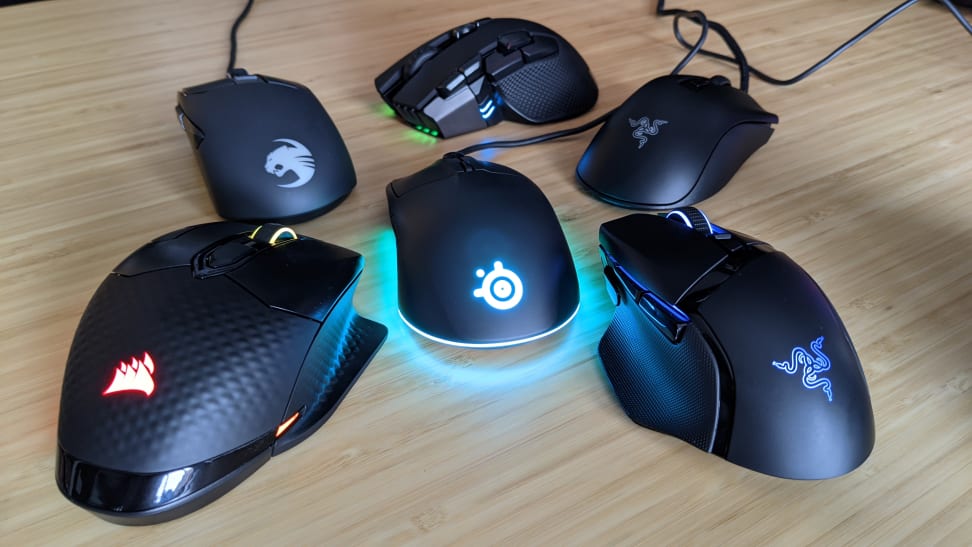 — Recommendations are independently chosen by Reviewed’s editors. Purchases you make through our links may earn us a commission.
— Recommendations are independently chosen by Reviewed’s editors. Purchases you make through our links may earn us a commission.The best gaming mouse can give you a competitive edge when you venture online to pit your skills against other gamers. Along with a great keyboard, it can help to boost your single-player performance. Gaming mice are designed to be comfortable, capable companions that feel like an extension of your arm. Pulsing lights are the norm, and companion software empowers you to fine-tune performance to suit your style or even the game you’re playing.
The best gaming mice are also highly sensitive, and they arm you with an array of extra controls at your fingertips. Our top pick is the Corsair Dark Core RGB Pro SE (available at Amazon) which strikes the perfect balance between comfort, customizability, performance, and price. Smooth wireless connectivity, great accuracy, and a clever design combine to make this the best gaming mouse for most people. We tried plenty of worthy alternatives to suit different needs and budgets, of course, so we have no doubt you’ll find the perfect mouse for you below.
These are the best gaming mice we tested, ranked in order:
- Corsair Dark Core RGB Pro
- SteelSeries Rival 3
- Cooler Master MM711
- Razer Basilisk Ultimate
- Corsair Ironclaw RGB
- Glorious PC Gaming Race Model O Wireless
- Logitech G502 Lightspeed
- Roccat Burst Pro
- Corsair Sabre RGB Pro Wireless Champion Series
- SteelSeries Rival 3
- Roccat Kain 120 AIMO
- SteelSeries Sensei Ten
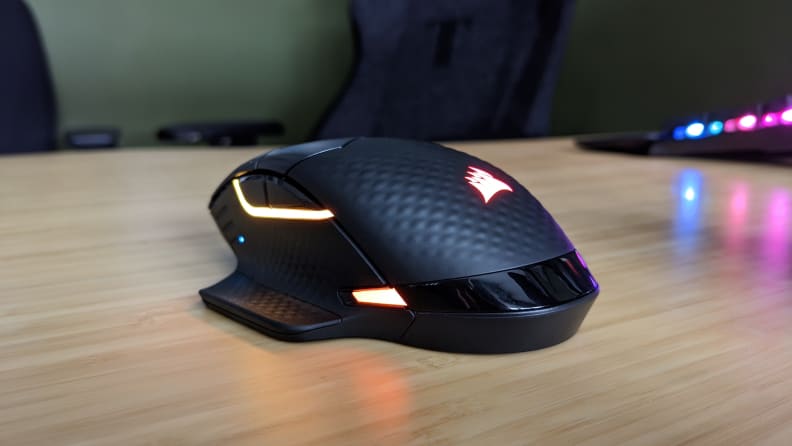

The Corsair Dark Core RGB Pro is our favorite wireless gaming mouse.
Comfort and grip are supreme with this full-featured, right-handed, wireless gaming mouse which packs in an impressive amount for the money. It’s quite large and weighty, so it’s best suited to larger hands. There’s a textured surface for enhanced grip on your palm and there’s a textured thumb rest on the left. You can remove the right-side panel (which reveals a slot for the USB receiver) and switch in a textured pinkie rest to keep your hand completely off the desktop. It’s incredibly comfortable to use for long periods.
Connectivity is seamless, thanks to Corsair’s Slipstream technology which can switch channels on the 2.4 GHz frequency automatically. There’s also Bluetooth support as a backup. This mouse handles frenetic in-game action with aplomb, boasting a sensor that goes up to 18,000 DPI with a 2,000 Hz polling rate. There are eight programmable buttons you can remap or customize with shortcuts and macros. You’ll also find nine RGB lighting zones. Everything is configured via Corsair’s iCue software, which takes some concentration to get to grips with, but proves to be very versatile indeed, offering deep customizability.
With a suggested battery life of up to 50 hours, the Corsair Dark Core RGB Pro has some stamina, though you’ll need to be in power-saving mode with lighting off to get close to that time. There’s a USB-C port, so you can always plug in and keep playing when the battery runs down. If you really want Qi wireless charging support, you can get it for a price upgrade with the Dark Core Pro RGB SE. You could buy Corsair’s MM1000 Qi Wireless Charging Mouse Pad at $34.99, or you can charge the mouse on any Qi wireless charging pad. Just know that the wireless option can tend to add more to the bottom line than we feel is worth it at most retailers.
Weighing up the feature list here, the $79.99 price is currently unbeatable, especially if wireless charging isn't a big deal to you. At the end of our testing, this was the mouse we wanted to return to. The Corsair Dark Core RGB Pro offers everything you could want in a gaming mouse.
Pros
-
Lots of useful buttons
-
Customizable lighting
-
Comfortable
Cons
-
Best with palm grip
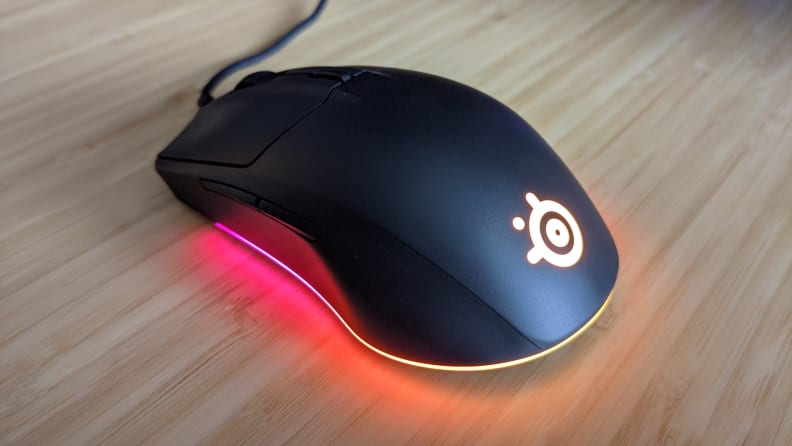

The SteelSeries Rival 3 offers excellent performance for the money.
Not everyone is willing to pay big bucks for a gaming mouse and the SteelSeries Rival 3 proves you don’t have to. It’s a small, lightweight wired mouse for right-handers that’s perfect for a comfortable claw or fingertip grip. At just 77 grams, with a thin 6-foot cable, it’s very easy to maneuver, and the build quality is solid.
You’ll find six buttons here and three RGB lighting zones. Everything can be configured via the SteelSeries Engine 3 software. The sensor in the Rival 3 tops out at a respectable 8,500 DPI and the polling rate goes up to 1,000 Hz. This mouse is no slouch in the performance stakes and keeps up with the action well. While it’s a tad small, there were no issues with accuracy.
The main attraction is the relatively low price. That’s a bargain for this kind of performance and while it lacks the bells and whistles of many of the other options here, we don’t think you’ll find anything better without spending a good bit more money. The SteelSeries Rival 3 is also compatible with both Windows and macOS.
Pros
-
Customizable lighting
-
Programmable buttons
Cons
-
Wired
-
Relatively few buttons
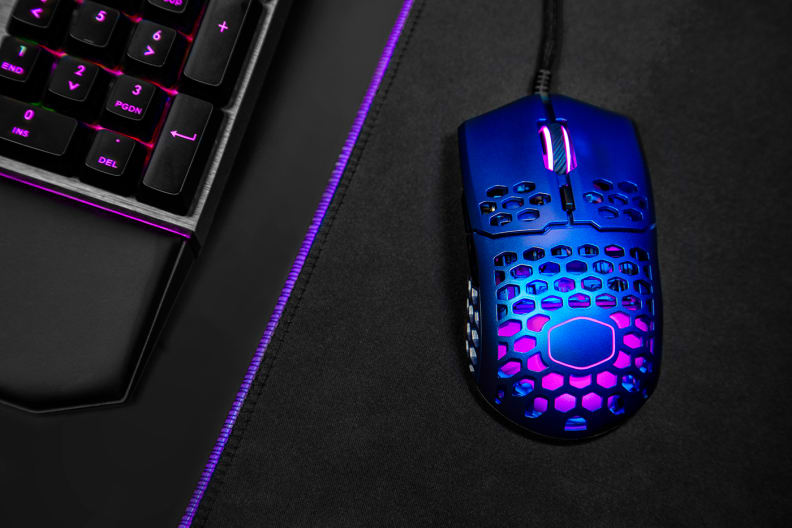

The Cooler Master MM711 features a compact, lightweight ambidextrous design.
With many people looking for a quality gaming mouse at an affordable price, something like the Cooler Master MM711 proves gaming isn’t only for the super-rich. It features a compact, lightweight ambidextrous design that has features every gamer wants. This wired mouse weighs only 60 grams and has a durable six-foot ultra weave cable and a honeycomb shell design to maximize performance and comfort.
The honeycomb shell design is one of the best parts of this gaming mouse. While using the device for a long time (gaming or working my nine-to-five job), my hand never got tired and never got sweaty due to the unique ventilated design. The MM711’s ambidextrous design is a also blessing for left-handed gamers like myself. While I’ve trained myself to use right-handed devices, this mouse feels more natural for me to use and immensely improved my productivity. However, if you are right-handed it’ll be easier for you to use the two fully customizable buttons near your thumb.
Other features of the Cooler Master MM711 gaming mouse that everyone can take advantage of include the 16,000 DPI optical sensor for minimal lag, little-to-no stuttering, and superior tracking. Coupled with the white PTFE feet, you are looking at smooth control and precise targeting in any game you play. The mouse is also fully supported on both Windows and Mac platforms, however, Cooler Master’s MasterPlus+ software for configuring RGB colors and button profiles is restricted to PC platforms at this time. The MM711 has a USB-A connection, so depending on your computer’s port availability you may need an adapter.
The overall value of the Cooler Master MM711 gaming mouse is incredible, making its low retail price a huge draw. Compared to the competition, like the SteelSeries Rival 3, it’s a few dollars more, but you get a device with a better build quality, more RGB customization options, and an ambidextrous design. Plus you can use it as an everyday mouse in addition to gaming. While the MM771 doesn’t pack some of the higher-end features you’ll find on something like the Logitech G502, there isn’t a better value for the price than with this mouse.
Pros
-
Customized RGB lighting
-
Form factor
Cons
-
Wired
How We Tested Gaming Mice
The Testers
Simon Hill has more than a decade of experience reviewing all sorts of consumer technology. Before he was a writer, he worked as a game designer for many years and had a serious first-person shooter habit. He works on a computer all day and often plays games long into the night, so a good gaming mouse is essential to him.
Matthew Prunty is a freelance gaming and tech journalist with over a decade of writing experience covering everything from video games hard and software to smartphones and PC hardware. For over a decade, he has owned and operated his own multimedia website Gaming Evolution where he wrote features, reviews, conducted interviews, roundups, and more. Born and raised in California, Matthew holds a Master’s degree in Business Finance from Strayer University lives with his wife and daughter. Enjoys gaming, binge-watching shows, and exploring futuristic tech.
The Tests
Every gaming mouse I tested was used for at least three days. I worked through a normal day with each mouse, writing, researching, and running through typical administrative tasks. At night, each mouse was put through its paces in marathon gaming sessions with a range of different titles, including first-person shooters, real-time strategy games, and more sedate management sims.
What You Should Know About Gaming Mice
How to Choose a Gaming Mouse
Wired vs. Wireless: The debate between wired and wireless gaming mice used to be straightforward, with wired mice preferred by gamers looking to eliminate any lag between muscle movement and onscreen action. Nowadays, the top wireless mice offer seamless connectivity and no perceptible lag. The lack of a cable makes them easier to move around without any drag or risk of getting snagged, but the trade-off is that they need to have batteries inside, which makes them heavier, and they inevitably need to be charged up from time to time. Some high-end gaming mice offer wireless charging now and you can even snag wireless charging mouse mats.
Size, weight, and feel: Choosing the right size and weight for you is all about how a mouse feels in hand, so it’s a good idea to test them out before you buy whenever possible. Many gaming mice are right-handed only, so southpaws will have a more limited choice. You’ll want to take your preferred grip style (discussed above) into account.
Programmable buttons: All gaming mice offer buttons that can be remapped using the manufacturer’s software. Many of them offer extra buttons to change the DPI on the fly, but you can also map additional buttons to specific shortcuts or create macros that trigger a series of actions with a single button press. Your gaming habits figure here. MMO players will likely want lots of buttons, while FPS players tend to prefer fewer options. Sometimes you’ll find specialist inclusions like a sniper paddle or button that can be depressed to drop the DPI temporarily for accurate aiming.
Customizable lighting: RGB lighting seems to be a standard feature in gaming mice now. It’s easy to turn off if you don’t care for it, but if you like to enhance your gaming with a light show then you should check into the manufacturer’s software and see how many customizable lighting zones your prospective mouse has and where they are.
Portability: If you plan to take your gaming mouse on the road, then you might want the ability to store customized profiles onboard. The top gaming mice have memory for a few profiles. For wireless mice, you should also check that there’s a compartment to store the USB receiver in.
Terms You Should Know
DPI: Dots Per Inch is the number of pixels your cursor can move across per inch of movement from your hand. While you may assume higher is better, it depends on your preferences, screen resolution, and the game you’re playing. A good gaming mouse will offer several preset DPI levels and make it easy for you to switch as required.
RGB: This stands for Red Blue Green and means you can change the color of the lights on your gaming mouse. Most gaming mice have some RGB lighting, but the number of zones and the available lighting effects differs from device to device and brand to brand.
Grip styles: Palm, Claw, and Fingertip are the three main grip styles you’ll hear about. Most people have a preferred grip style, but it’s not uncommon to change your grip for different games. Generally, larger, heavier mice favor a palm grip while smaller, lighter mice work well with a fingertip grip.
Polling rate: This refers to how often your mouse is checking its position and reporting it to your computer and is measured in Hertz (Hz). A polling rate of 1,000 Hz indicates that your mouse is reporting its position 1,000 times per second. If you like to use a high DPI, then you’ll want a high polling rate to go with it.
Other Gaming Mice We Tested
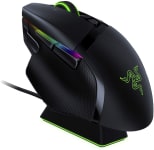
At the expensive end of Razer’s mouse range, with an off-putting $169.99 price, the Razer Basilisk Ultimate sits proudly atop its angled charging cradle. As the name implies, this wireless gaming mouse has everything. It looks fantastic with no fewer than 14 customizable lighting zones, an elongated left mouse button, hard angles, and textured sides for enhanced grip. It will suit large hands and a palm grip best, but it’s light enough for claw or fingertip grips, with a textured thumb rest on the left that means it’s only suitable for right-handers.
There are 11 programmable buttons and a large scroll wheel that you can finetune for the perfect tension level. Movement is silky smooth and lightning-fast, and the Basilisk offers laser accuracy with an exceptionally reliable wireless connection and zero perceptible delays. Every element of this mouse can be tweaked to your liking. Dig into Razer’s Synapse software and you can customize everything, taking DPI up to a maximum of 20,000, calibrating for different surfaces, and choosing preset lighting effects or creating your own.
The Razer Basilisk Ultimate is an absolute pleasure to use throughout the workday and then long into the night for gaming, which is possible thanks to the long battery life. The option to switch to a wired connection if the battery runs out on you is handy but rarely needed. When you’re done, it slots onto the charging cradle like a small desktop sculpture. We also appreciate the optional sniper paddle, which you can hold down with your left thumb for a temporary DPI switch that makes precise aiming much easier.
The only thing that gives us pause in recommending the Razer Basilisk Ultimate is the price, which will be impossible to justify for most people. Otherwise, it’s an absolute dream mouse.
Pros
-
Lots of useful buttons
-
Customizable lighting
-
Sniper paddle and charge dock
Cons
-
Not the best value

With a sharp, angular style, three RGB lighting zones, ten programmable buttons, and slick wireless connectivity the Corsair Ironclaw RGB is a versatile gaming mouse. It boasts an attractive design and excellent build quality. It’s big and tall with a pronounced peak, textured grip on the sides, and it’s a right-handed mouse. It will suit palm grips best, though fingertip or claw grips are possible for those with larger hands. At 130 grams, it is quite heavy, so it might not suit FPS fanatics.
The Corsair Ironclaw RGB is a wireless mouse and can connect using Corsair’s “Slipstream” technology which jumps channels on the 2.4GHz frequency automatically to keep you seamlessly connected. It feels very responsive and we didn’t encounter any lag. There’s also Bluetooth support as a backup and you also have the option of plugging in via the charging cable for a wired connection. A customizable DPI goes up to 18,000 for extreme accuracy, and your current level is displayed on the side via three LEDs.
To get the best from the Corsair Ironclaw RGB, you’ll want to install the iCue software. This allows you to set up lighting effects; map keys, shortcuts, and macros to buttons; choose your DPI presets, and a host of other specifics to get the right feel for you. We didn’t like the defaults, but after fiddling around with iCue, we began to appreciate the Ironclaw. You can set up profiles for different games and there’s onboard storage for three profiles.
The rechargeable battery can go for 16 hours connected via Slipstream with the lighting on and it takes around two hours to recharge. Considering the versatility, top-notch wireless connectivity, and a long list of features on offer here, the price tag feels reasonable.
Pros
-
Lots of useful buttons
-
Customizable lighting
Cons
-
Best for large hands
-
No wireless charging
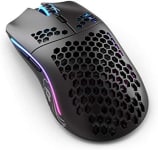

Weighing in at just 69 grams the wireless Glorious Model O is an absolute dream for gamers with a need for speed. Ultra-lightweight gaming mice have been growing in popularity as they allow for quick fluid movements with the minimum of effort, which is especially important in first-person shooter games where every millisecond counts. Combine that low weight with incredible sensitivity up to 19,000 DPI and special PTFE (Teflon) mouse feet for minimal friction on any surface and you have a dangerously fast gaming mouse.
To keep the weight down, the Glorious Model O has a shell with a honeycomb design which also looks seriously cool. The hexagonal holes reduce the weight and encourage airflow, but they do also let in dust and dirt. There’s RGB lighting with three separate zones you can customize via the Glorious Core software, which also allows you to create profiles for different games and configure the six programmable buttons.
You may worry about durability with something this light, but the Glorious Model O feels tough enough to stand up to long gaming sessions and the Omron mechanical switches are good for 20 million clicks. Battery life can be pushed to 72 hours with lighting turned off, but you also get a highly flexible, lightweight cable to plug into the USB-C port when the power runs out.
While it’s not cheap, the Glorious Model O Wireless is our favorite ultra-lightweight mouse and you can also save considerably if you opt for the wired version instead. If you want to go as light as possible Glorious recently released the wired Model O Minus at 58 grams, which is the lightest mouse on the market at the time of writing. But at 69 grams we think the Model O Wireless will be light enough for most people. This gaming mouse is almost effortless to use and it’s very comfortable. For certain games, its winning combination of speed and accuracy makes a real difference.
Pros
-
Wireless
-
Very lightweight
-
Customizable lighting
Cons
-
No Bluetooth
-
No dongle storage

Building on the popular G502 range, the Lightspeed improves on its predecessors by cutting the cable, shedding some weight, and improving the sensor. The tweaks are all on the inside, as the G502 Lightspeed has the same angular exterior as the old Proteus Spectrum, which will be good news for gamers used to that design. It’s a right-handed mouse in matte black with a rubberized thumb rest and side panel for enhanced grip. Compartments make space for a set of small weights, so you can tune the feel of this mouse.
Performance is fast, accurate, and completely lag-free. The sensor goes up to 16,000 DPI and features 1,000 Hz polling rates. There are 11 programmable buttons within easy reach, and you can use Logitech’s G hub software to map them, set up macros, and create shortcuts. This mouse also features fully customizable RGB lighting with various effects and the option to create your own.
As a wireless gaming mouse battery life is a potential issue, particularly if you like lighting effects. Logitech supplies a USB-C charging cable and you can always plug in and continue to play when the battery runs low. There’s also an optional Powerplay wireless charging mouse mat, though it’s pricey and slightly reduces your weight customization options as you have to insert the wireless charging puck.
Pros
-
Feature packed
-
Classic design
-
Wireless charging
Cons
-
Not totally suitable for small hands
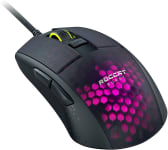
This is another ultra-lightweight mouse for esports players and gamers looking for frictionless performance. It weighs just 68 grams, offers sensitivity up to 16,000 DPI, and has six programmable buttons. The aptly named PhantomFlex cable is 5.9 feet long and not only does it keep tangles away, but you’ll also barely notice it’s there. PTFE (Teflon) feet ensure this mouse slides easily on any mouse mat or desktop.
While Roccat has gone for the same honeycomb design as most other ultra-lightweight mice, there is a very thin skin completely covering it. That means it’s not as eye-catching as something like the Glorious Model O, but it is easier to keep clean. The placement of the lighting is a slight disappointment as it’s mostly covered by your hand when in use and there’s only one zone. You can customize the lighting and tweak other mouse settings in Roccat’s Swarm software.
Accurate and comfortable for long gaming sessions, the Roccat Burst Pro is a solid choice for gamers seeking something lightweight. However, it is quite pricey for a wired mouse with these features, especially since options like the wired Glorious Model O can be had for less.
Pros
-
Very lightweight
-
Programmable buttons
-
Comfortable
Cons
-
Wired
-
Limited lighting

Comfort, practicality, and function are must-haves for any great wireless gaming mouse, and the Corsair Sabre RGB Pro Wireless has all of those things. It’s a right-handed device with a larger, weightier size compared to other gaming mice, but that allows it to conform to the contours of your hand for better control. On the bottom, there is a storage compartment to store the USB receiver when not in use and a switch to control how the mouse connects to your computer.
There are three different ways to connect this mouse to your computer: Corsair’s Slipstream technology, Bluetooth, and via supplied USB-A to USB-C cable. Through the Slipstream tech and supplied USB-A adapter, you can switch channels on the 2.4 GHz frequency ensuring your mouse has sub-1ms wireless transmission connection speeds. Bluetooth is supported as a backup option. The USB-A to USB-C cable charges the internal battery on the Sabre RGB Pro and allows the mouse to be used in a wired capacity. There are seven programmable buttons, dynamic two-zone RGB backlighting and both are fully customizable via the iCUE software. Designed to handle anything thrown its way, it includes Omron switches that support up to 50 million clicks, and a sensor supporting up to 26,000 DPI.
Details aside, the Sabre RGB Pro Wireless shares a lot in common with its wired counterpart the Corsair Sabre RGB Pro, though it makes concessions in a few key areas. For one, the polling rate in the Pro Wireless is a fourth of the capability of the wired version. The mouse has a traditional look and feel to its design, which will appeal to many, but it doesn’t stand out in a sea of competitive gaming mice. The battery life lasts up to 90 hours with RGB turned off and connected via Bluetooth. Via Slipstream, you are looking at about 60 hours.
Within our time using the mouse, we can say that those figures hold up. When the battery level got close to dying out, there was no dip in performance, either. For those with systems that lack USB-A ports, you’ll need a USB-A to USB-C adapter. Looking over the features, the $109.99 price should appeal to those looking for a class-leading device catered to gamers. There are competing products that offer a similar experience at a lower price point like the Corsair Sabre RGB Pro and the Razer Basilisk X HyperSeed, but to match what this mouse brings to your experience, you will find yourself spending even more.
Pros
-
Fully customizable
-
Multiple connection methods
-
Comfortable
Cons
-
Right-handed only

Easily one of the best gaming mice available, Razer’s Deathadder V2 is a popular pick for gamers of all kinds. The Deathadder V2 Mini takes most of what’s great about the design and shrinks it down a little for smaller hands. Razer has managed to shave a fraction of an inch from the width and height and shed one of the buttons next to the mouse wheel, but the Mini retains the same shape. This is the lightest gaming mouse we’ve used, at just 62 grams, and it’s effortless to move, with a braided power cable that never gets in the way.
The Razer Deathadder V2 Mini comes with optional grips that you can affix if you feel the need. The response time is 0.2 milliseconds, there are six programmable buttons, and the DPI sensor goes up to 8,500. That’s a long way short of the regular Deathadder V2 which tops out at 20,000 DPI. Still, the Deathadder V2 Mini is very responsive and accurate for first-person shooting and third-person action. It’s perhaps too small and light for adults, but perfect for kids.
Like most of Razer’s wares, the Deathadder V2 Mini can be customized via the Synapse software. It also supports Razer Chroma RGB, so you can pick from various lighting effects or create your own if you have the patience to work through the complicated editor. Some of the scaled-down elements of the Deathadder V2 Mini are more pleasing than others, but the best is the lower price. At $49.99, this mouse costs $20 less than the regular Deathadder V2.
Pros
-
Customizable lighting
-
Programmable buttons
-
Very light
Cons
-
Wired
-
Best for small hands

Most gaming mice have sharp, angular designs with countless programmable buttons on them, but the Roccat Kain 120 AIMO is relatively subtle and minimalist. It’s gently shaped for right-handers, with two buttons where your thumb rests, and a good gap between the left and right mouse buttons where you’ll find a DPI button and a wide, clickable, notched mouse wheel. It’s a wired mouse that weighs in at 89 grams, with a permanently attached braided cable that’s 5.9 feet long. Although there are no textured grips, the soft-touch coating feels grippy and durable.
It feels very responsive in everyday use and it never let us down while gaming. The DPI goes up to 16,000, way beyond what most people will need. You can remap buttons, set up macros, and tweak a few other settings using Roccat’s Swarm software, but note that it doesn’t work with macOS. We particularly like the option to set up different profiles for different games, and you can save up to five of them on the mouse itself.
The AIMO RGB lighting is also fairly subdued, with just the Roccat logo and mouse wheel lighting up. You can choose various preset lighting effects or set up your own using Swarm. While we found the Roccat Kain 120 AIMO comfortable to use throughout the day and appreciated the handy DPI button and the feel of the mouse wheel, it doesn’t set your pulse racing and we were a little surprised by the relatively high price for the package.
Pros
-
Customizable lighting
-
Programmable buttons
-
Good performance
Cons
-
A little dull
-
Lacks grips

Ambidextrous designs are in short supply, so the SteelSeries Sensei Ten is sure to pique the interest of left-handed gamers. This is a low-profile, lightweight mouse at 92 grams, and it has a lovely, soft-touch finish that makes it extremely comfortable to use for long periods, but also enhances your grip. The thin 6.75-foot cable won’t get in your way and there’s a symmetrical button design, so you can use this mouse whether you’re right or left-handed.
We have no complaints about the performance of this mouse. The sensor goes up to 18,000 DPI and has a 1,000 Hz polling rate. You can use the SteelSeries Engine 3 software to map the eight buttons, but there are only two RGB lighting zones, comprising the logo, which tends to be under your hand, and the mouse wheel.
Unfortunately, the design was a deal-breaker because we kept accidentally pressing the right-side buttons. The features are also somewhat lacking for the asking price, but if you prefer an understated style that focuses on performance, particularly if you’re left-handed, the SteelSeries Sensei Ten might be your ideal gaming mouse.
Pros
-
Designed for right or left hand
-
Very comfortable
Cons
-
Easy to hit the wrong button
-
Limited feature set
